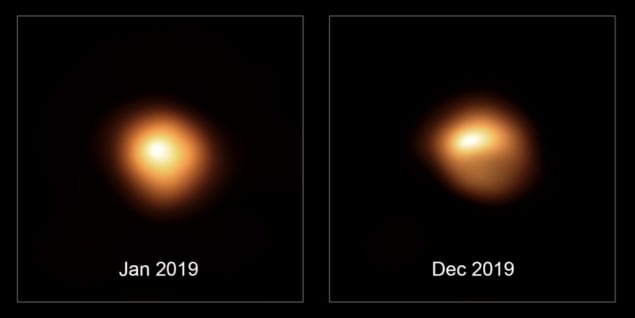
An international team of astronomers has proposed a telescope to monitor the bright star Betelgeuse to provide clues about the cause of its sudden drop in brightness. The Betelgeuse Scope concept – which is anticipated to cost about $0.4m – would use twelve off-the-shelf 10 cm-aperture telescopes secured to a radio telescope dish to provide detailed, nightly observations of the supergiant star.
Betelgeuse’s “great dimming” began late last year and changed the naked-eye appearance of the constellation Orion. With it continuing to enthral astronomers, theories have emerged to explain why Betelgeuse’s glow has plummeted. A leading contender is that the star’s surface churned out an immense dust cloud that hid some of its famously ruddy light. To closely scrutinize this “mass-loss” activity, researchers will need frequent, high-resolution views of the roiling surface of the star, which are difficult to acquire with most telescopes right now, but possible via interferometry by connecting several telescopes as if they were one instrument.
The idea of a dedicated Betelgeuse Scope is a really nice one
Graham Harper
The team is building a prototype of the Betelgeuse Scope that would be placed on a University of Arizona 6.1 m radio antenna and are now seeking funding for the final telescope. “If successful, we will bring it to a larger antenna [of] 12 m or more to increase the interferometer array size,” says astronomer Narsireddy Anugu from the University of Arizona, who is leading the project. By using relatively inexpensive instruments affixed to the structure of an already-constructed radio telescope, the final Betelgeuse Scope system should be cheaper than a more complex, conventional arrangement. “It also saves money by using the pointing and tracking of the existing radio antenna,” adds Anugu. “So we don’t have to build it for all the individual amateur optical telescopes.”
A step forward
Graham Harper, an astrophysicist at the University of Colorado who has studied Betelgeuse and is not associated with the Betelgeuse Scope, says that if the proposal is successful then it would be “a major step forward” beyond existing observations. “Coordinating major observatories to look at a common object is difficult enough, even for one-off events, but for systematic monitoring of a couple of sources it is totally impractical,” he says. “The idea of a dedicated Betelgeuse Scope is a really nice one, because it attempts to address this problem.” Astronomers plan huge neutrino observatory in the Pacific Ocean
According to Harper, the proposed telescope would also glean information about Betelgeuse’s surface temperature. “They should be able to determine how the surface temperatures change with time across the stellar surface,” he adds. “This would help tell us exactly where the interesting phenomena are occurring, for example shock waves, outbursts and ejections.”



